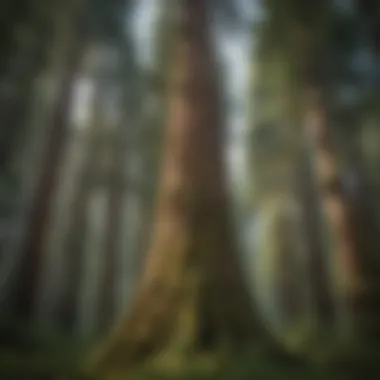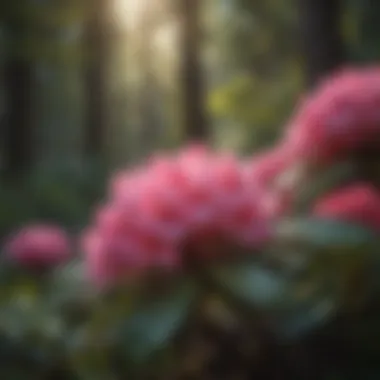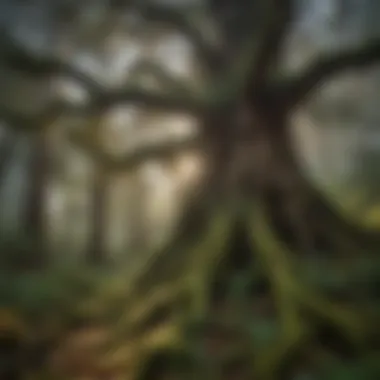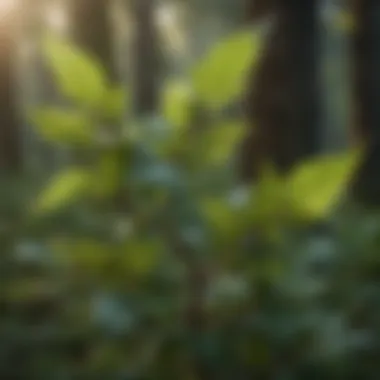Discovering the Diverse Native Flora of the Pacific Northwest


Evergreen Trees Species
Evergreen trees in the Pacific Northwest region contribute significantly to the diverse ecosystem present there. These trees, such as the iconic Douglas fir and Western red cedar, are vital components of the region's flora. The Douglas fir, scientifically known as Pseudotsuga menziesii, dominates the landscape with its towering presence and needle-like leaves, while the Western red cedar, or Thuja plicata, offers not only beauty but also a host of ecological benefits.
Types of Evergreen Trees
The Pacific Northwest boasts a rich variety of evergreen trees, from the majestic Douglas fir to the enchanting Western red cedar. Other notable species include the Sitka spruce, grand fir, and Alaska cedar, each adding its unique charm to the forested expanses.
Ecological Significance
Evergreen trees play a crucial role in maintaining biodiversity and ecological balance in the Pacific Northwest. These trees provide habitat and food for various wildlife species, contribute to soil stability, and help sustain the intricate web of life in the region.
Conservation Practices
Conservation efforts are essential to safeguard the evergreen tree species in the Pacific Northwest. Practices such as sustainable forest management, tree planting initiatives, and the establishment of protected areas help in preserving the richness of these iconic trees for future generations.
Introduction to Pacific Northwest Flora
Overview of the Region's Botanical Diversity
The Influence of Climate and Geography
The Pacific Northwest's botanical diversity is intricately tied to its climate and geography. The region's temperate rainforest climate, characterized by mild, wet winters and dry summers, creates an ideal habitat for a wide array of plant species. The significant influence of the Pacific Ocean moderates temperatures and fosters lush vegetation. This unique climate promotes the growth of diverse flora, including towering conifers and delicate wildflowers, contributing to the overall vibrancy of the region's ecosystem.
Adaptations of Native Plants
Native plants in the Pacific Northwest have evolved remarkable adaptations to thrive in their environment. From needle-like leaves of conifers to succulent characteristics of some understory plants, these adaptations reflect the plants' strategies for survival and reproduction. The ability to withstand seasonal changes and variable moisture levels underscores the resilience of native flora in the face of environmental challenges, showcasing the intricate balance between plants and their ecosystem.
Importance of Biodiversity
The biodiversity of the Pacific Northwest's flora is crucial for ecosystem health and resilience. A diverse range of plant species provides essential habitat and food sources for various wildlife, fostering interconnected ecosystems. Furthermore, plant biodiversity contributes to soil fertility, watershed protection, and climate regulation. Understanding the importance of maintaining this rich botanical diversity is fundamental for preserving the region's ecological balance and promoting sustainability.
Historical and Cultural Significance
Native American Traditional Uses
The indigenous peoples of the Pacific Northwest have long relied on native plants for food, medicine, shelter, and ceremonial practices. The traditional knowledge passed down through generations highlights the deep connection between native plants and cultural identity. By exploring the historical use of plants such as cedar, salmonberry, and stinging nettle, we gain insights into the diverse ways in which native flora have enriched the lives of Native American communities.


Impact of Colonization
The arrival of European settlers in the Pacific Northwest reshaped the landscape and disrupted traditional plant use practices of indigenous communities. Colonization led to the displacement of Native American tribes, loss of cultural knowledge, and conversion of forested lands for agriculture and urban development. The impact of colonization on native plant communities underscores the importance of recognizing historical injustices and fostering efforts to preserve traditional ecological knowledge.
Conservation Efforts
In response to the threats facing native plant species, conservation efforts have gained momentum in the Pacific Northwest. Organizations and initiatives dedicated to preserving plant biodiversity, restoring habitats, and promoting sustainable land management practices play a crucial role in safeguarding the region's botanical heritage. Through collaborative conservation strategies, communities can work towards mitigating the impacts of habitat loss, invasive species, and climate change on native flora, ensuring their long-term survival and ecological significance.
Coniferous Giants: Iconic Trees of the Pacific Northwest
In this section of the article
Vibrant Wildflowers and Understory Plants
In the diverse ecosystem of the Pacific Northwest, vibrant wildflowers and understory plants play a crucial role in enhancing biodiversity and ecosystem health. These delicate floral species, often overshadowed by the towering conifers, provide essential habitats and food sources for various wildlife, contributing to the intricate web of life in the region. Their presence not only adds vibrant colors and textures to the forest floor but also signifies the resilience and adaptability of native flora in challenging environmental conditions. Exploring the intricate relationships between wildflowers and understory plants unveils a hidden world of interconnectedness and symbiosis, showcasing the silent but impactful contributions of these often-underappreciated botanical wonders.
Trillium (Trillium ovatum)
Ecological Role
Trillium, with its distinct three-petaled white flowers, plays a vital ecological role as a keystone species in the Pacific Northwest. Its presence indicates the health of the surrounding ecosystem, serving as an indicator of environmental conditions and soil quality. Trillium populations are strong indicators of the integrity of the forest understory and its ability to support diverse plant and animal species. By studying trillium populations, ecologists can gain valuable insights into the overall health and resilience of forest ecosystems, making it a pivotal element in ecologic assessment and conservation efforts.
Cultural Significance
The cultural significance of trillium stems from its revered status among Native American tribes in the region. Traditionally, trillium was used for medicinal purposes and symbolized purity and rebirth in native folklore. Its presence in indigenous rituals and ceremonies further underscores its cultural importance, highlighting the deep-rooted connection between native flora and traditional practices. Understanding the cultural significance of trillium enriches our appreciation for its significance beyond its ecological role, bridging the gap between the natural world and human cultures.
Conservation Status
Despite being a charismatic and iconic species, trillium faces conservation challenges due to habitat loss and over-harvesting. The delicate balance between human activities and the preservation of these wild populations calls for concerted conservation efforts and sustainable management practices. Establishing protected areas, monitoring wild populations, and promoting awareness about the importance of conserving trillium are crucial steps in ensuring the continued existence of this culturally and ecologically significant plant species in the Pacific Northwest.
Aquatic and Wetland Plants of the Region
Pacific Waterleaf (Hydrophyllum tenuipes)
Adaptations to Moist Environments:
The Pacific Waterleaf's adaptations to moist environments are fundamental to its survival and thriving in wetland habitats. It possesses specialized structures and mechanisms that enable it to efficiently absorb and retain water, essential for sustaining its growth and development in high-moisture conditions. These adaptations help the plant withstand periods of flooding and waterlogging, ensuring its long-term presence in its habitat. The unique feature of the Pacific Waterleaf's adaptation lies in its ability to thrive in constantly changing water levels, showcasing its resilience and adaptability to wetland environments.


Ecosystem Functions:
The Ecosystem Functions of the Pacific Waterleaf are integral to the overall health and stability of wetland ecosystems in the Pacific Northwest. It plays a crucial role in nutrient cycling, supporting the growth of other plant species and providing food and shelter for various wildlife. Through its interactions with soil microorganisms and other aquatic species, the Pacific Waterleaf contributes to the overall ecological balance of wetland environments. Its ability to filter and purify water also enhances the quality of wetland habitats, making it a valuable component of the region's ecosystem.
Conservation Challenges:
Despite its ecological importance, the Pacific Waterleaf faces conservation challenges due to habitat loss and degradation in the Pacific Northwest. Human activities such as urban development, agriculture, and pollution threaten the survival of this species by altering its natural habitat and disrupting its ecological functions. Conservation efforts are crucial to safeguarding the Pacific Waterleaf and the fragile wetland ecosystems it inhabits. Addressing these challenges requires collaborative initiatives between government agencies, conservation organizations, and local communities to preserve and restore wetland habitats for the long-term sustainability of the Pacific Waterleaf and other wetland plants.
Skunk Cabbage (Lysichiton americanus)
Growth Habit and Reproduction:
Skunk Cabbage's unique growth habit and reproduction strategies are key aspects of its ecological significance in wetland environments. It exhibits an impressive ability to thrive in anaerobic soils through its specialized root system, enabling it to access essential nutrients and moisture in low-oxygen conditions. Moreover, its efficient reproductive mechanisms, including heat generation to pierce through frozen ground, ensure successful propagation and colonization in wetland habitats. The distinctive feature of Skunk Cabbage's growth habit and reproduction lies in its adaptation to extreme environmental conditions, showcasing its resilience and persistence in wetland ecosystems.
Role in Wetland Ecology:
Skunk Cabbage plays a vital role in wetland ecology by contributing to nutrient cycling and supporting a diversity of wetland species. Its large leaves provide shade and shelter for amphibians and insects, while its foul-smelling flowers attract pollinators essential for plant reproduction. Additionally, Skunk Cabbage's ability to bioaccumulate heavy metals helps in maintaining water quality in wetland environments, highlighting its function as a natural bioindicator of environmental health. The unique feature of Skunk Cabbage's role in wetland ecology lies in its multifaceted interactions within the ecosystem, promoting biodiversity and ecosystem resilience.
Ethnobotanical Uses:
Skunk Cabbage holds cultural and traditional significance in indigenous communities, with ethnobotanical uses extending beyond medicinal and culinary practices. Native tribes have utilized various parts of the plant for medicinal purposes, treating ailments such as headaches, respiratory issues, and inflammations. Additionally, Skunk Cabbage has ceremonial value in indigenous rituals, symbolizing purification and protection. Its unique feature as an ethnobotanical resource highlights the deep connection between humans and wetland plants, embodying a rich history of traditional knowledge and sustainable practices. However, overexploitation and habitat destruction pose threats to these cultural uses, emphasizing the need for sustainable harvesting and conservation measures to preserve Skunk Cabbage's ethnobotanical legacy in the Pacific Northwest.
Threats to Native Plant Diversity
Invasive Species and Habitat Loss
In discussing the critical theme of Threats to Native Plant Diversity within the context of the broader exploration of Pacific Northwest flora, it becomes evident that invasive species and habitat loss pose significant challenges to the region's indigenous plant species. The interaction between invasive plant species and native flora can have profound implications for the delicate ecological balance of the Pacific Northwest.
Impact on Indigenous Flora
The impact of invasive species on indigenous flora is a central aspect that demands attention. These non-native species often outcompete and displace native plants, leading to a reduction in biodiversity and disrupting crucial ecological relationships. Understanding the specific ways in which invasive species affect indigenous flora is essential to developing effective conservation strategies and safeguarding the unique plant diversity of the region.
Challenges for Restoration
Addressing the challenges associated with restoring native plant populations in the face of invasive species requires both scientific expertise and community engagement. Restoration efforts must contend with factors such as propagule pressure, competition, and habitat alteration resulting from invasive plants. Overcoming these challenges demands a multifaceted approach that integrates ecological research, strategic planning, and active restoration practices to ensure the long-term viability of native plant communities.
Community Involvement


Community involvement in the conservation and restoration of native plant species plays a pivotal role in addressing the threats posed by invasive species and habitat loss. By fostering grassroots initiatives, raising awareness, and promoting citizen science projects, local communities can contribute significantly to the protection of indigenous flora. Engaging the public in conservation efforts not only amplifies the impact of restoration projects but also cultivates a sense of environmental stewardship and shared responsibility for preserving the botanical heritage of the Pacific Northwest.
Preserving the Botanical Heritage
In this section of the article, we delve into the critical importance of preserving the rich botanical heritage of the Pacific Northwest. This topic holds significant relevance within the broader context of ecosystem conservation and sustainable environmental practices. Exploring the indigenous flora of the region unveils a treasure trove of unique plant species that contribute not only to the aesthetic beauty of the landscape but also to the overall ecological balance.
Preserving the botanical heritage of the Pacific Northwest safeguards the genetic diversity of native plants, ensuring their survival for future generations to appreciate and study. By protecting these plant species, we also uphold the complex relationships they have established within their respective habitats, promoting ecosystem resilience and stability.
Conservation Practices and Organizations
National and Regional Initiatives
Delving into the realm of national and regional initiatives focused on plant conservation, we encounter a multifaceted approach aimed at preserving the botanical heritage of the Pacific Northwest. These initiatives encompass a wide range of strategies, from habitat restoration programs to the establishment of protected areas designated for native plant conservation.
One key characteristic of these initiatives is their collaborative nature, bringing together government agencies, non-profit organizations, research institutions, and local communities to work towards a common goal of biodiversity conservation. The cooperative efforts of these diverse stakeholders ensure a holistic approach to plant preservation, leveraging collective expertise and resources for maximum impact.
A unique feature of national and regional initiatives is their emphasis on long-term sustainability and adaptive management practices. By incorporating scientific research, monitoring protocols, and community engagement strategies, these initiatives strive to create resilient conservation frameworks that can withstand evolving environmental challenges. While these efforts face constraints such as limited funding and competing interests, their dedication to safeguarding native plants exemplifies a steadfast commitment to botanical heritage preservation.
Community-Based Conservation
Community-based conservation initiatives play a vital role in preserving the botanical heritage of the Pacific Northwest by fostering grassroots involvement and local empowerment. These initiatives empower communities to take ownership of conservation projects, instilling a sense of stewardship towards native plant species and their habitats.
One key characteristic of community-based conservation is its emphasis on educational outreach and capacity-building within local populations. By providing training, resources, and networking opportunities, these initiatives enable community members to actively participate in conservation efforts, leading to increased awareness and appreciation of the region's botanical diversity.
A unique feature of community-based conservation is its ability to forge strong connections between people and plants, transcending mere conservation practices to cultivate a deeper sense of ecological responsibility and cultural pride. Despite facing challenges such as limited funding and organizational support, these initiatives demonstrate the power of collective action in protecting and celebrating the botanical heritage of the Pacific Northwest.
Education and Outreach
Education and outreach initiatives play a pivotal role in raising awareness about the importance of preserving the botanical heritage of the Pacific Northwest. By engaging diverse audiences through informative campaigns, workshops, and educational programs, these initiatives inspire a sense of environmental stewardship and promote sustainable practices that support native plant conservation.
One key characteristic of education and outreach efforts is their ability to bridge the gap between scientific knowledge and public understanding, translating complex ecological concepts into accessible and relatable information. By communicating the value of native plants in a compelling and inclusive manner, these initiatives foster a sense of connection and responsibility towards the region's botanical treasures.
A unique feature of education and outreach activities is their potential to inspire future generations of conservationists and environmental advocates, cultivating a legacy of respect for nature and a commitment to preserving the botanical heritage of the Pacific Northwest. Despite challenges such as limited resources and outreach barriers, these initiatives highlight the transformative power of education in catalyzing positive change towards a more sustainable and biodiverse future.
Public Engagement and Advocacy
In this section, we delve into the crucial aspects of public engagement and advocacy within the realm of native plant conservation in the Pacific Northwest. These fundamental components serve as catalysts for raising awareness, mobilizing communities, and driving policy changes that support the preservation of the region's botanical heritage.
Promoting Native Plant Awareness
Sustainable Land Use Planning
Connecting with Local Ecosystems.



